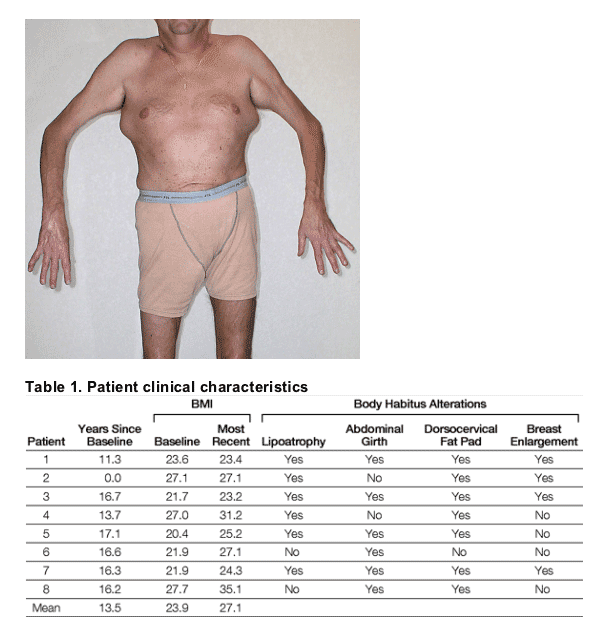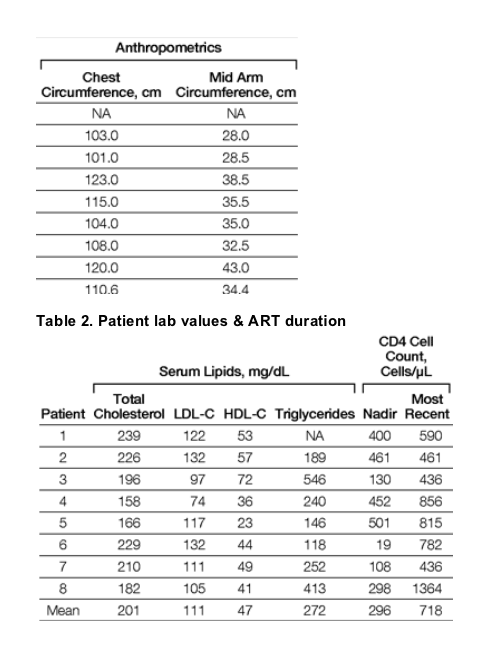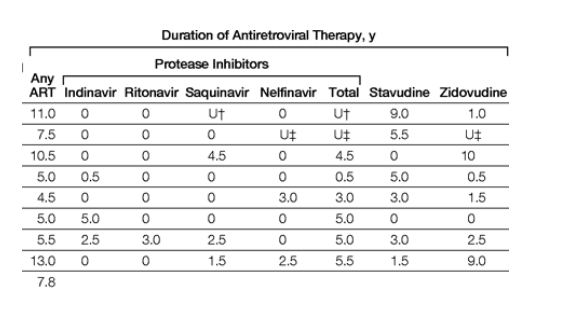| |
A Novel Pattern of Lipoaccumulation in HIV-Infected Men
|
| |
| |
Journal of the American Medical Association
Vol. 296 No. 7, August 16, 2006
To the Editor: Body habitus changes among persons infected with human immunodeficiency virus (HIV) who receive highly active antiretroviral therapy (HAART) are major concerns, in part because of their frequent association with insulin resistance and hyperlipidemia. The desire to avoid such changes has influenced selection of antiretrovirals and timing of HAART initiation. Lipoatrophy is of particular cosmetic concern to affected individuals. It is most commonly manifested as limb and gluteal fat loss with consequent apparent thinning of the extremities and facial fat loss with a "sunken cheek" appearance.1-2 Lipoaccumulation most often appears as visceral abdominal adiposity with increased abdominal girth. Other manifestations include dorsocervical fat pads ("buffalo humps") and neck lipoaccumulation ("bull neck").
We report what we believe to be a novel manifestation of lipoaccumulation in 8 men with HIV infection.
Methods
All individuals are HIV-infected participants in the Multicenter AIDS Cohort Study (MACS), a longitudinal study of men who have sex with men. The original cohort included 5622 men. Since 1984, MACS participants have undergone clinical evaluation twice yearly. Since 1999, anthropometrics (height; weight; and circumference of chest, waist, hip, thigh, and mid proximal arm) and examiner- and self-reported body habitus changes have been recorded, as have diagnoses of hyperlipidemia, hyperglycemia, diabetes mellitus, and hypertension. Blood measurements include serum lipid levels, glucose levels, and CD4 cell count determinations. Patients self-designate race. Institutional review board approval was obtained for MACS and all participants gave written informed consent.
Results
An initial observation of a novel type of lipoaccumulation was made by a MACS clinician in Pittsburgh, Pa. Seven other cases were subsequently identified study-wide. Mean age was 44.6 years (range, 39-52 years). Six patients were white and 2 were Asian/Pacific Islander.
All patients had bandlike accumulations of lipomatous-appearing tissue extending bilaterally and symmetrically from the breasts laterally into the axillae (Figure). In some patients, this fatty tissue extended further posteriorly, with a near-circumferential distribution. None of these persons had notable soft tissue nodularity, tenderness, evidence of mastitis or other acute inflammation or infection, or the presence of new or enlarged axillary lymphadenopathy. None had hypogonadism. All had preexisting lipoaccumulation (evidenced in at least 1 other bodily area [eg abdomen, dorsocervical area]) before the unique pattern of lipoaccumulation was noted but not before HAART was initiated; 6 had limb and facial lipoatrophy (Table 1). Body mass index measurements were not indicative of obesity. Four of the 8 participants reported a history of hyperlipidemia; none reported a history of hyperglycemia or diabetes mellitus.
One participant had a history of an AIDS-defining illness; 3 had a nadir CD4+ cell count of less than 200/ƒÊL (Table 2). Mean number of years of antiretroviral therapy received at the time of identifying the lipoaccumulation was 7.8 (range, 4.5-13 years). Six patients were receiving HAART at the time of identification, 4 with regimens including protease inhibitors. All participants had a history of receiving protease inhibitor therapy. All participants had elevation in at least 1 measurement of serum low-density lipoprotein cholesterol, triglycerides, or total cholesterol during at least 1 visit.
Comment
We believe that these patients demonstrate a previously unreported manifestation of lipoaccumulation. We were not able to identify the specific cause. Lipoatrophy has been associated with stavudine or zidovudine use, lipoaccumulation and insulin resistance with protease inhibitor use, and hyperlipidemia with any of these therapies.3-5 Other possible risk factors are HIV disease stage, age, race, and sex.6 Since all 8 men had preexisting lipoaccumulation of some kind, this type of lipoaccumulation may represent a progression for some of the individuals. None were obese. Treatment-related etiologic factors were not readily apparent, but all had received protease inhibitor-containing HAART.
Our database has limitations on potentially relevant clinical information. Because we have not yet been able to undertake systematic review of all MACS participants for the presence of this lipoaccumulation, a prevalence estimate cannot yet be reliably ascertained. There is not a single objective measure that can be systematically applied to all MACS participants specifically to discern this phenomenon. In addition, retrospective analyses do not allow for precise measurement of time of onset. Comparative evaluation and prospective observation are needed to further characterize this clinical entity.
Figure. Example of a Novel Type of Lipoaccumulation in Men Infected With Human Immunodeficiency Virus
Affected areas are symmetric and extend from the breasts bilaterally into the axillae as well as posteriorly.



|
|
| |
| |
|
|
|